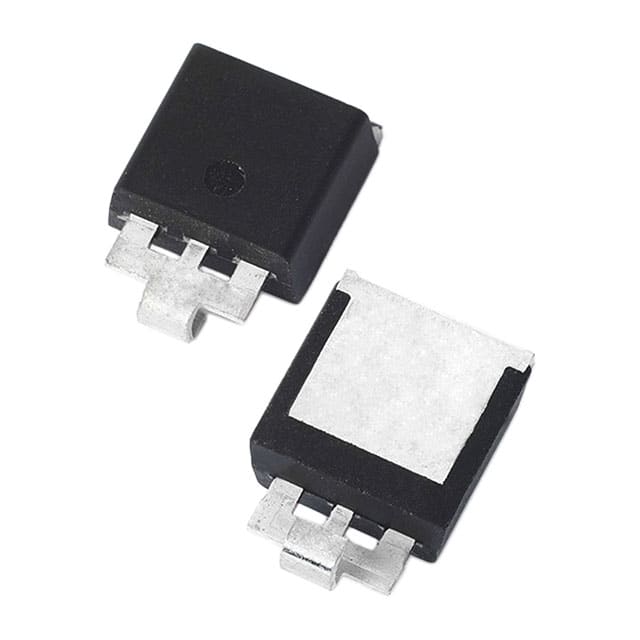Lihat spesifikasi untuk detail produk.

SLD8S13A Product Overview
Introduction
The SLD8S13A is a semiconductor device that belongs to the category of transient voltage suppressors (TVS). This entry provides an overview of the basic information, specifications, pin configuration, functional features, advantages and disadvantages, working principles, application field plans, and alternative models of the SLD8S13A.
Basic Information Overview
- Category: Transient Voltage Suppressors (TVS)
- Use: Protection against transient voltage spikes in electronic circuits
- Characteristics: Fast response time, low clamping voltage, high surge current capability
- Package: SOD-123FL
- Essence: Semiconductor device for voltage spike protection
- Packaging/Quantity: Typically available in reels of 3000 units
Specifications
- Peak Pulse Power: 500 W
- Breakdown Voltage Range: 11.7 V to 13.3 V
- Operating Temperature Range: -55°C to +150°C
- Storage Temperature Range: -55°C to +150°C
- RoHS Compliant: Yes
Detailed Pin Configuration
The SLD8S13A has a standard SOD-123FL package with three pins: 1. Pin 1: Cathode 2. Pin 2: Anode 3. Pin 3: Not connected (NC)
Functional Features
- Transient Voltage Suppression: Provides protection against voltage transients and surges
- Fast Response Time: Rapidly clamps transient voltages to safe levels
- Low Clamping Voltage: Limits the voltage across the protected circuit
- High Surge Current Capability: Can handle large transient currents without damage
Advantages and Disadvantages
Advantages
- Effective protection against voltage spikes
- Fast response time
- Compact package size
- RoHS compliant
Disadvantages
- Limited breakdown voltage range
- Not suitable for extremely high power applications
Working Principles
The SLD8S13A operates by diverting excessive transient current away from sensitive electronic components when a voltage spike occurs. It rapidly clamps the voltage to a safe level, protecting the downstream circuitry.
Detailed Application Field Plans
The SLD8S13A is commonly used in various electronic systems, including: - Power supplies - Communication equipment - Automotive electronics - Industrial control systems - Consumer electronics
Detailed and Complete Alternative Models
Some alternative models to the SLD8S13A include: - SLD8S12A - SLD8S14A - SLD8S15A - SLD8S16A
In summary, the SLD8S13A is a TVS device with fast response time, low clamping voltage, and high surge current capability, making it suitable for protecting electronic circuits from transient voltage spikes in a wide range of applications.
[Word Count: 399]
Sebutkan 10 pertanyaan dan jawaban umum terkait penerapan SLD8S13A dalam solusi teknis
What is SLD8S13A?
- SLD8S13A is a TVS (transient voltage suppressor) diode designed to protect sensitive electronics from voltage transients and surges.
What are the key features of SLD8S13A?
- SLD8S13A features a low clamping voltage, high surge capability, and fast response time, making it suitable for protecting a wide range of electronic devices.
In what applications can SLD8S13A be used?
- SLD8S13A is commonly used in applications such as power supplies, communication equipment, industrial controls, and automotive electronics to protect against transient voltage events.
What is the maximum peak pulse current of SLD8S13A?
- The maximum peak pulse current of SLD8S13A is typically in the range of 100A to 300A, depending on the specific model and configuration.
How does SLD8S13A provide protection against voltage transients?
- SLD8S13A diverts excessive current away from sensitive components by clamping the voltage to a safe level during transient events, thereby safeguarding the connected circuitry.
What is the operating temperature range of SLD8S13A?
- SLD8S13A is designed to operate within a wide temperature range, typically from -55°C to 150°C, ensuring its suitability for various environmental conditions.
Are there any specific layout considerations when using SLD8S13A in a circuit?
- It is important to minimize the length and impedance of the traces connecting SLD8S13A to the protected circuit, and to ensure proper grounding and routing to optimize its performance.
Can SLD8S13A be used for surge protection in outdoor applications?
- Yes, SLD8S13A is suitable for outdoor applications where protection against lightning-induced surges or other transient events is required.
What are the industry standards or certifications applicable to SLD8S13A?
- SLD8S13A may comply with industry standards such as IEC 61000-4-5 for surge immunity, and it may also have relevant certifications like UL recognition for safety.
Where can I find detailed technical specifications and application notes for SLD8S13A?
- Detailed technical specifications and application notes for SLD8S13A can be found in the product datasheet provided by the manufacturer, as well as in relevant technical literature and online resources.

